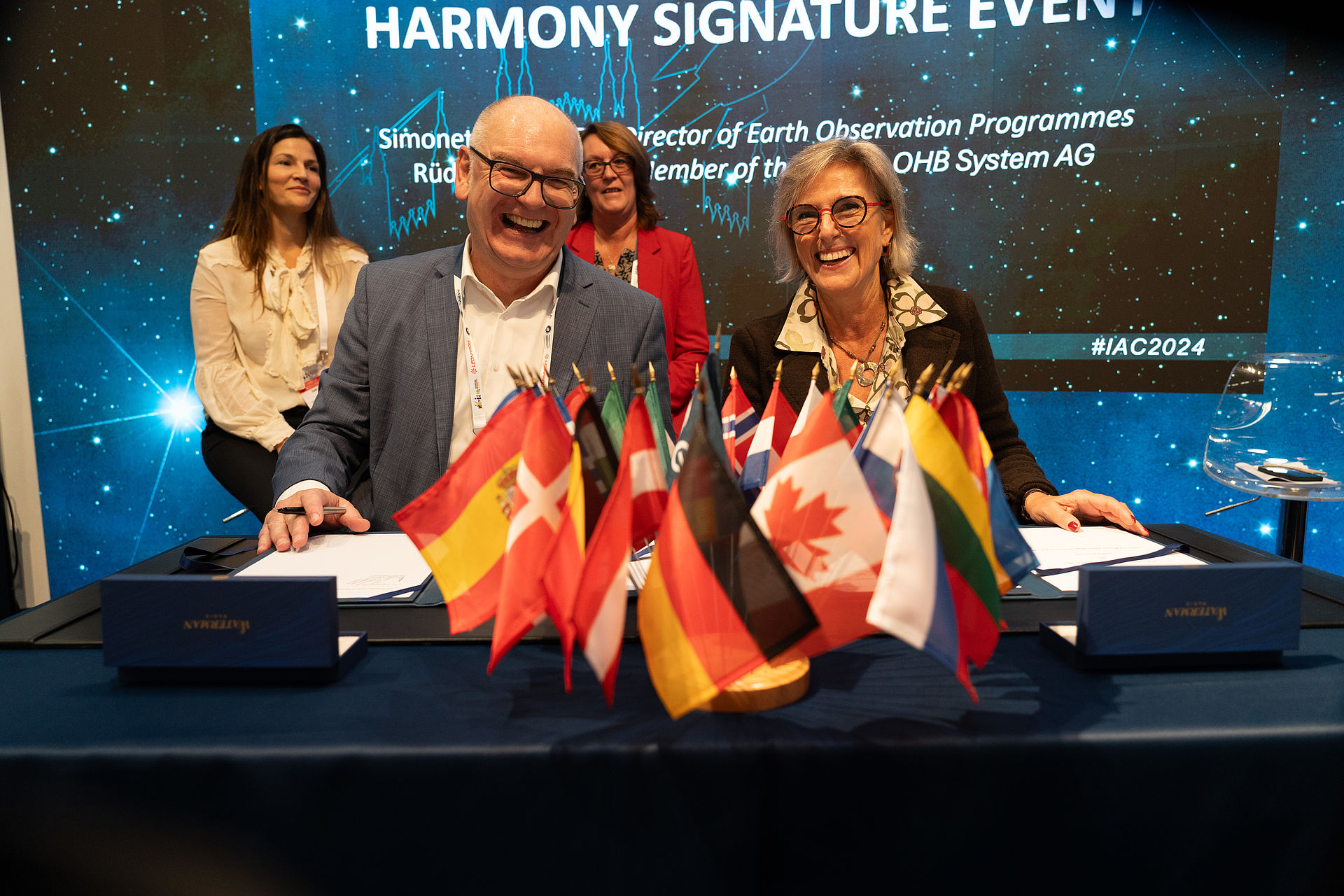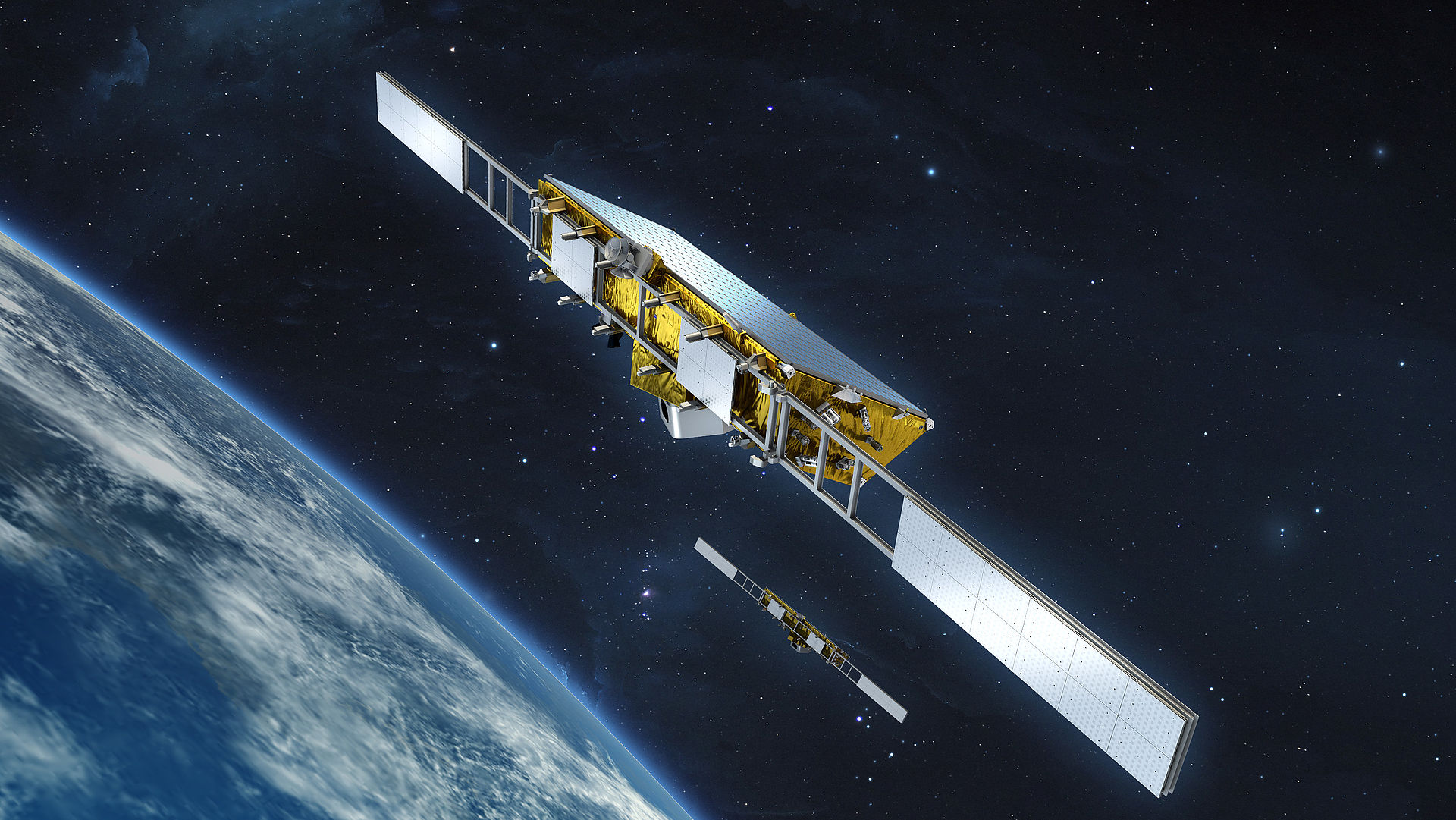Press Release
Space company OHB has won a €280 million contract to develop two new ESA Earth Explorer science and research satellites
Harmony mission will yield a wealth of new scientific information about ocean–atmosphere coupling, ice dynamics and land deformation for scientific research and support action to tackle climate change

Milan / Bremen, 15 October 2024 - OHB System AG, a subsidiary of the space and technology group OHB SE, has been selected by the European Space Agency, ESA, as the prime contractor for the ‘Earth Explorer 10’ Harmony mission. The contract, worth over EUR 280 million, covers the management of the industrial consortium as well as the development and construction of two new Earth observation satellites part of ESA's FutureEO programme. The contract was signed today by Simonetta Cheli, ESA Director of Earth Observations Programmes, and by Rüdiger Schönfeld, Board Member at OHB System AG, at the 75th International Astronautical Congress (IAC) in Milan.
“We are very pleased and proud to be developing this important and complex Earth observation mission as prime contractor. Harmony will provide valuable data to the scientific community to better understand our system Earth and climate change,” said Rüdiger Schönfeld.
Simonetta Cheli said: “By providing a diverse array of high-resolution measurements of motion occurring at or near Earth's surface, we fully expect Harmony to build on the success of our other Earth Explorer missions. These missions have made significant contributions gaps in our knowledge of how Earth works. And now, Harmony is poised to further enhance our understanding of by delivering valuable data that will benefit Earth system science and climate research. We are thrilled to award the industrial contract, worth over €280 million, to OHB System AG as prime contractor for the two Harmony Satellites.”
In convoy with Sentinel-1: special features and objectives of the Harmony mission
OHB is to develop two Earth observation satellites for the Harmony mission. The satellites will join the Copernicus Sentinel-1D satellite in space to fly in tandem and exploit its transmitted radar signals. Both Harmony satellites carry a passive synthetic aperture radar (SAR) instrument and a multi-view thermal infrared (TIR) instrument. “This is the first mission for which OHB will combine a radar instrument and an optical payload on one satellite. Technically, this is a major challenge. At the same time, to fly the first multistatic radar mission is exciting; two new satellites from us are flying with a Copernicus satellite, Sentinel-1, and would need to synchronise their radar signal’ explained Harmony project manager Agustina Alvarez Toledo.
The two Harmony satellites will fly in a sun-synchronous orbit at an altitude of 693 kilometers. The launch of the mission is planned for 2029. The aim is to observe small-scale movement and deformation fields of the ocean surface, glaciers and ice sheets, sea ice and the solid Earth.
Florence Hélière, Harmony Project Manager, added, “The expertise and commitment of our industrial partners are invaluable assets to the Harmony mission, helping us achieve our rendezvous with Sentinel-1 and advance our scientific understanding of the Earth system.”
Why is this important and what exactly does the scientific community want to observe?
For the oceans, Harmony will enable the characterization and quantification of small-scale ocean dynamics to understand sub-mesoscale circulation and vertical pumping processes. In terms of sea ice drift velocity and deformation, Harmony observations will help to better estimate sea ice roughness and thickness and thus support the development of sea ice models for forecasting and mass balance studies. This will also allow the dynamics of the sea ice and the processes in the marginal zone of the ice to be recognized and understood more precisely in future.
In addition, the data will close existing gaps in the observation of temporal changes in the volume and mass of glaciers and ice caps and their contribution to sea level change. The deformation and flow dynamics of ice sheets and glaciers will also be investigated, as well as the processes that influence their stability and dynamic response to climate change.
In monitoring solid land, Harmony will help to quantify deformation fields and topography changes, such as tectonic changes and elevation changes on volcanoes. The data from the Harmony mission will later be used for land monitoring, disaster and crisis management, geo-resources and geo-risks, the marine environment and coastal waters.
Partners of the Harmony mission
As prime contractor, OHB System AG leads the industrial consortium with 45 companies, including many SMEs, from 15 ESA member states. Thales Alenia Space Italia is the SAR payload prime and supplies the two radar instruments. The compact thermal infrared (TIR) camera is supplied by ABB from Canada. The industrial consortium will be expanded by around 10 companies through further tenders.
Contact for media representatives:
Marianne Radel
Head of Corporate Communications
Phone: +49 421 2020 9159
Email: marianne.radel@ohb.de
Contact for investors and analysts:
Marcel Dietz
Investor Relations
Phone: +49 421 2020 6426
Email: ir@ohb.de

